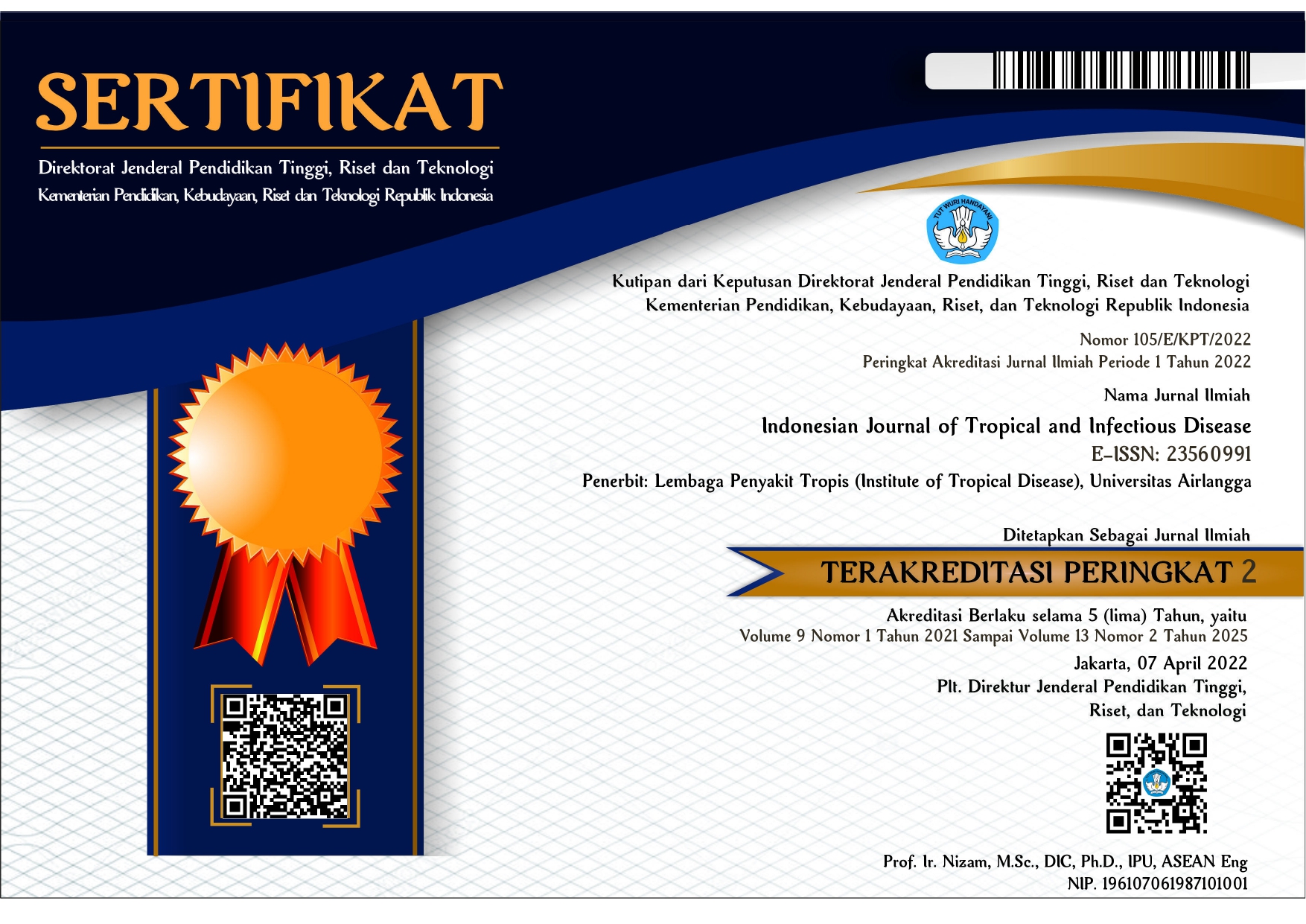Clinical Patterns and Demographic Characteristics of Dermatophytosis in Surabaya
Downloads
Dermatophytosis, the most common fungal infection in humans, significantly impacts quality of life due to its clinical and cosmetic effects. Its high prevalence underscores the need to evaluate patient profiles to improve management strategies. This study aim is to identify the most prevalent type of dermatophytosis, patient demographics, clinical characteristics, laboratory investigations, and therapy in dermatophytosis into the clinical and epidemiological characteristics of dermatophytosis in a tropical, high-burden region. This descriptive retrospective study used total sampling of medical records of dermatophytosis patients from January 2017 to December 2022. Tinea corporis and tinea cruris was the most common, while tinea manuum is the least common dermatophytosis. Female adults were the most affected group. Common clinical features for each type included alopecia for tinea capitis, erythematous macules for other types, and nail dystrophy for tinea unguium. Trichophyton mentagrophytes was the commonest pathogen in 2017. Most of the therapies followed Clinical Practice Guidelines with extensive use of griseofulvin and ketoconazole cream. Further research should explore therapeutic outcomes, preventive measures, and factors influencing recurrence and adherence to treatment.
Mochizuki T, Tsuboi R, Iozumi K, Ishizaki S, Ushigami T, Ogawa Y, et al. Guidelines for the management of dermatomycosis (2019). J Dermatol [Internet]. 2020 Dec 1 [cited 2023 Mar 27];47(12):1343–73. Available from: https://pubmed.ncbi.nlm.nih.gov/32978814/
Havlickova B, Czaika VA, Friedrich M. Epidemiological trends in skin mycoses worldwide. Mycoses [Internet]. 2008 Sep [cited 2023 Mar 18];51(SUPPL.4):2–15. Available from: https://onlinelibrary.wiley.com/doi/full/10.1111/j.1439-0507.2008.01606.x
Son JH, Doh JY, Han K, Kim YH, Han JH, Bang CH, et al. Risk factors of dermatophytosis among Korean adults. Sci Rep [Internet]. 2022 Dec 1 [cited 2023 Mar 18];12(1). Available from: /pmc/articles/PMC9352717/
Gnat S, Łagowski D, Nowakiewicz A. Genetic Predisposition and its Heredity in the Context of Increased Prevalence of Dermatophytoses. Mycopathologia [Internet]. 2021 May 1 [cited 2023 Apr 19];186(2):163. Available from: /pmc/articles/PMC8106586/
Kovitwanichkanont T, Chong AH. Superficial fungal infections. Aust J Gen Pract. 2019 Oct 1;48(10):706–11.
Kizny Gordon A, McIver C, Kim M, Murrell DF, Taylor P. Clinical application of a molecular assay for the detection of dermatophytosis and a novel non-invasive sampling technique. Pathology [Internet]. 2016 Dec 1 [cited 2023 Mar 20];48(7):720–6. Available from: https://pubmed.ncbi.nlm.nih.gov/27780596/
Chamorro MJ, House SA. Tinea Manuum. J Am Acad Dermatol [Internet]. 2022 Aug 8 [cited 2023 Mar 20];11(2):300–1. Available from: https://www.ncbi.nlm.nih.gov/books/NBK559048/
Narang T, Bhattacharjee R, Singh S, Jha K, Kavita, Mahajan R, et al. Quality of life and psychological morbidity in patients with superficial cutaneous dermatophytosis. Mycoses [Internet]. 2019 Aug 1 [cited 2023 Apr 3];62(8):680–5. Available from: https://onlinelibrary.wiley.com/doi/full/10.1111/myc.12930
Noviannisa FA, Astari L, Alimsardjono L. Clinical and Cure Profile of Tinea Capitis Patients [Internet]. 2022. Available from: https://e-journal.unair.ac.id/BIKK
Verma SB, Panda S, Nenoff P, Singal A, Rudramurthy SM, Uhrlass S, et al. The unprecedented epidemic-like scenario of dermatophytosis in India: I. Epidemiology, risk factors and clinical features. Indian J Dermatol Venereol Leprol [Internet]. 2021 Mar 23 [cited 2023 Mar 20];87(2):154–75. Available from: https://www.ijdvl.com/the-unprecedented-epidemic-like-scenario-of-dermatophytosis-in-india-i-epidemiology-risk-factors-and-clinical-features/
Agarwal U, Saran J, Agarwal P. Clinico-mycological study of dermatophytes in a tertiary care centre in northwest India. Indian J Dermatol Venereol Leprol. 2014;80(2):194.
Poluri LV, Indugula JP, Kondapaneni SL. Clinicomycological Study of Dermatophytosis in South India. J Lab Physicians. 2015 Jul 19;7(02):084–9.
Sharma R, Adhikari L, Sharma R. Recurrent dermatophytosis: A rising problem in Sikkim, a Himalayan state of India. Indian J Pathol Microbiol. 2017;60(4):541.
Field LA, Adams BB. Tinea pedis in athletes. Int J Dermatol. 2008 May 14;47(5):485–92.
Zhou Z, Liu T, Zhang Z. Skin disease in United Nations peacekeepers in Lebanon. J R Army Med Corps. 2017 Feb;163(1):27–30.
Devy D, Ervianti E. Studi Retrospektif: Karakteristik Dermatofitosis (Characteristic of Dermatophytosis: A Retrospective Study). 2018.
Putri AI, Astari L. Profile and Evaluation of Dermatophytosis. Berkala Ilmu Kesehatan Kulit dan Kelamin [Internet]. 2017 Aug 20 [cited 2023 Apr 20];29(2):135–41. Available from: https://e-journal.unair.ac.id/BIKK/article/view/5563
Coulibaly O, L’Ollivier C, Piarroux R, Ranque S. Epidemiology of human dermatophytoses in Africa. Med Mycol [Internet]. 2018 Feb 1 [cited 2023 Mar 23];56(2):145–61. Available from: https://pubmed.ncbi.nlm.nih.gov/28992062/
Kang S, Amagai M, Bruckner AL, Enk AH, Margolis DJ, McMichael AJ, et al. Fitzpatrick’s Dermatology. 9th ed. Sewon Kang, Masayuki Amagai, Anna L. Bruckner, Alexander H. Enk, David J. Margolis, Amy J. McMichael, et al., editors. Vol. 1. McGraw-Hill Education; 2019.
Keshwania P, Kaur N, Chauhan J, Sharma G, Afzal O, Alfawaz Altamimi AS, et al. Superficial Dermatophytosis across the World’s Populations: Potential Benefits from Nanocarrier-Based Therapies and Rising Challenges. ACS Omega. 2023 Sep 5;8(35):31575–99.
Seidel D, Wurster S, Jenks JD, Sati H, Gangneux JP, Egger M, et al. Impact of climate change and natural disasters on fungal infections. Lancet Microbe. 2024 Jun;5(6):e594–605.
Verma S, Vasani R, Reszke R, Matusiak Ł, Szepietowski JC. Prevalence and clinical characteristics of itch in epidemic‐like scenario of dermatophytoses in India: a cross‐sectional study. Journal of the European Academy of Dermatology and Venereology. 2020 Jan 11;34(1):180–3.
Pires CAA, Cruz NFS da, Lobato AM, Sousa PO de, Carneiro FRO, Mendes AMD. Clinical, epidemiological, and therapeutic profile of dermatophytosis. An Bras Dermatol. 2014;89(2):259–64.
Ervianti E, Salsabila A, Widia Y, Kawilarang AP. Cat Contact as A Risk Factor for Tinea Capitis Infection.
Venitarani SA, Handayani S, Ervianti E. Profile of patients with tinea capitis. Dermatol Reports. 2019 Mar 29;
Dalei SR, Nayak D, Bhue PK, Das NR, Behera B. Current Status of Dermatophytosis: A Hospital-Based Study in Northern Odisha, India. Cureus. 2023 Nov;15(11):e48664.
Siswati AS, Rosita C, Triwahyudi D, Budianti WK, Mawardi P, Dwiyana RF, et al. Panduan Praktik Klinis Perhimpunan Dokter Spesialis Kulit dan Kelamin Indonesia (PERDOSKI) Tahun 2021. 2021. 141–148 p.
Olson JM, Troxell T. Griseofulvin. In: StatPearls [Internet]. Treasure Island (FL): StatPearls Publishing; 2024 Jan– [updated 2023 Jul 31]. Available from: https://www.ncbi.nlm.nih.gov/books/NBK537323/
Panagiotidou D, Kousidou T, Chaidemenos G, Karakatsanis G, Kalogeropoulou A, Teknetzis A, et al. A Comparison of Itraconazole and Griseofulvin in the Treatment of Tinea Corporis and Tinea Cruris: A Double-Blindb Study. Journal of International Medical Research. 1992 Sep 1;20(5):392–400.
Angello JT, Voytovich RM, Jan SA. A cost/efficacy analysis of oral antifungals indicated for the treatment of onychomycosis: griseofulvin, itraconazole, and terbinafine. Am J Manag Care. 1997 Mar;3(3):443–50
Jartarkar SR, Patil A, Goldust Y, Cockerell CJ, Schwartz RA, Grabbe S, et al. Pathogenesis, Immunology and Management of Dermatophytosis. Journal of Fungi [Internet]. 2022 Jan 1 [cited 2023 Jun 8];8(1). Available from: /pmc/articles/PMC8781719/
Morishita N, Ninomiya J, Sei Y, Takiuchi I. Effects of Temperature, Humidity, Minor Injury and Washing on Penetration of Dermatophytes into Human Stratum Corneum. Nippon Ishinkin Gakkai Zasshi. 2003;44(4):269–71.
Copyright (c) 2024 Indonesian Journal of Tropical and Infectious Disease

This work is licensed under a Creative Commons Attribution-NonCommercial-ShareAlike 4.0 International License.
The Indonesian Journal of Tropical and Infectious Disease (IJTID) is a scientific peer-reviewed journal freely available to be accessed, downloaded, and used for research. All articles published in the IJTID are licensed under the Creative Commons Attribution-NonCommercial-ShareAlike 4.0 International License, which is under the following terms:
Attribution ” You must give appropriate credit, link to the license, and indicate if changes were made. You may do so reasonably, but not in any way that suggests the licensor endorses you or your use.
NonCommercial ” You may not use the material for commercial purposes.
ShareAlike ” If you remix, transform, or build upon the material, you must distribute your contributions under the same license as the original.
No additional restrictions ” You may not apply legal terms or technological measures that legally restrict others from doing anything the license permits.























